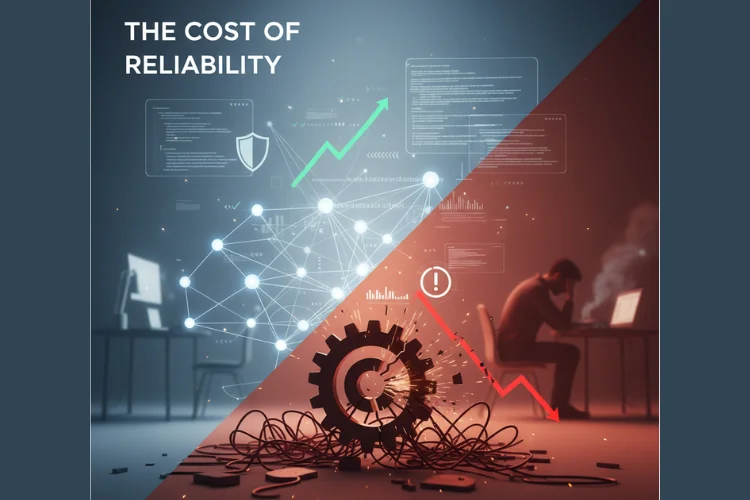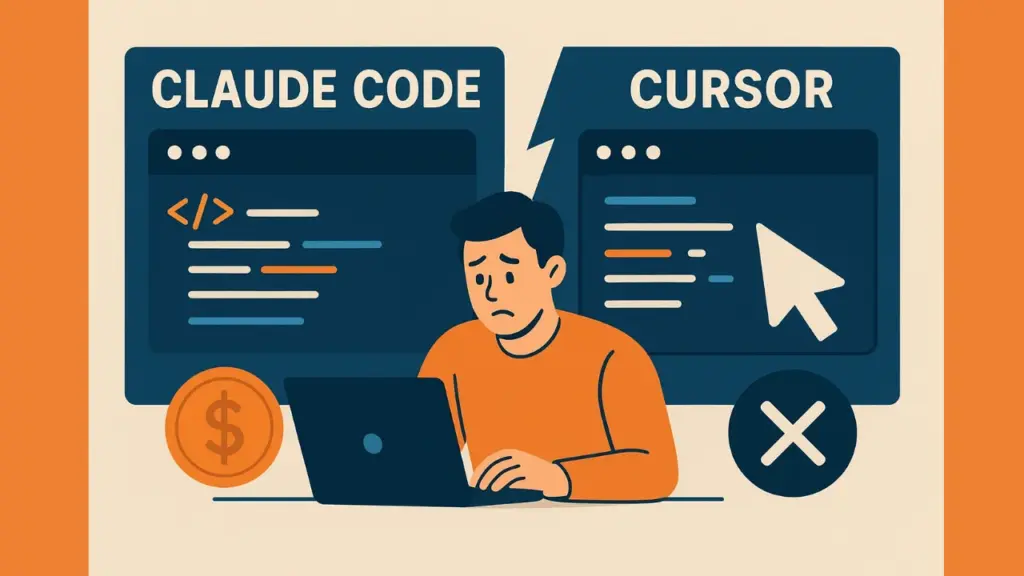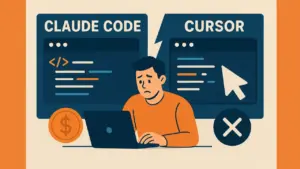1. Introduction: When AI Coding Tools Stop You in Your Tracks
Imagine paying $200 a month for a premium AI coding tool — and suddenly hitting a usage limit just one week in. That’s exactly what happened with Claude Code’s Max plan. My workflow came to a halt overnight. Meanwhile, Cursor users were facing their own chaos — surprise charges, confusing compute limits, and stories of developers being billed over $7,000 in a single day.
Both tools claim to revolutionize software development with AI-driven efficiency. Both have fans singing their praises online. But beneath the hype lies a tougher question — which one actually delivers when deadlines are real, and which one might cost you your peace (and wallet) mid-project?This blog dives deep into the real-world differences between Claude Code and Cursor, focusing on performance, reliability, cost transparency, and developer experience — no marketing fluff, just facts you can use.
2. The Rise of AI Coding Assistants
AI-assisted coding has gone from a novelty to a necessity. Developers now rely on AI tools for everything — from generating functions and fixing bugs to writing full applications. The landscape started with GitHub Copilot and quickly expanded to advanced tools like Claude Code by Anthropic and Cursor, an AI-native IDE assistant.
What makes these tools appealing is their promise: speed, accuracy, and fewer repetitive tasks. But as AI becomes embedded in every coding workflow, the risks grow too. Developers now face new challenges — subscription limits, usage quotas, and unpredictable billing systems.
For a fractional CTO or a tech leader managing multiple developers, these challenges are more than minor annoyances — they directly affect productivity, cost planning, and team morale. Choosing the right AI coding assistant isn’t just about speed; it’s about sustainable performance under pressure.
3. Claude Code: Premium Power, Pricey Problems
Claude Code entered the market with a strong promise — to bring deep contextual understanding and human-like reasoning into programming. It’s built on Anthropic’s Claude 3 model, which excels at reading complex codebases, identifying bugs, and explaining logic with precision.
Strengths:
- Exceptional accuracy and fewer logical bugs
- Handles multi-file projects with ease
- Provides detailed reasoning for debugging
- Excellent natural language explanations
However, that intelligence comes at a price — literally. The Claude Code Max plan costs $200 per month, and users are quickly discovering the pain of strict usage caps. Once the limit is hit, the model stops responding, sometimes for days. Imagine being halfway through a product sprint, and suddenly your AI assistant refuses to work.
Developers report productivity crashes after hitting limits unexpectedly. The issue isn’t just cost — it’s workflow reliability. For teams that depend on AI-assisted development daily, that kind of downtime can derail entire releases.
For individual developers or fractional CTOs managing multiple clients, Claude Code’s pricing model raises a serious question: are you paying for consistent productivity or just premium access with unpredictable breaks?
4. Cursor: Speed, Simplicity, and the Surprise Charges
If Claude Code represents “thoughtful precision,” Cursor represents “blazing speed.” Cursor integrates directly into your IDE (Visual Studio Code), making it feel like part of your natural coding environment. It autocompletes, fixes bugs, and even refactors entire code blocks in seconds.
Strengths:
- Fast response times and instant code generation
- Easy setup and IDE-native experience
- Efficient for quick debugging and testing
- Great for developers who value rapid iteration
But that convenience comes with another kind of risk — unclear billing and compute limits. Cursor uses a pay-per-compute system that many developers don’t fully understand. Users have shared cases of being charged hundreds or even thousands of dollars unexpectedly.
This lack of transparency creates anxiety. Developers start wondering if running one more code generation will trigger another big charge. That uncertainty kills the freedom that AI coding tools are supposed to offer.
A good AI coding assistant should empower creativity, not make you second-guess every command. For startups, freelancers, or fractional CTOs managing budgets, this unpredictability can become a serious financial issue.
5. Performance Comparison: Where Each Tool Shines (and Fails)
Let’s break down how both tools perform in key areas that matter most to developers:
|
Feature |
Claude Code |
Cursor |
|
Speed |
Slower but deliberate |
Blazing fast |
|
Accuracy |
High – fewer bugs |
Occasional syntax errors |
|
Context Understanding |
Excellent (multi-file, deep logic) |
Limited (mostly single-file) |
|
Debugging Support |
Explains reasoning in detail |
Auto-fixes errors instantly |
|
Ease of Use |
Chat-based interface |
IDE-integrated experience |
|
Billing Transparency |
Fixed but capped |
Variable and unclear |
|
Reliability |
Stable but restrictive |
Dynamic but risky |
Both tools have their strengths — Claude Code is ideal for large-scale, thoughtful development, while Cursor thrives in fast-paced prototyping environments. The best choice depends on whether your priority is accuracy or speed.
6. The Cost of Reliability: What Developers Need to Consider
When evaluating AI tools, the biggest hidden factor isn’t just speed or features — it’s reliability. A tool that stops working mid-project or generates unpredictable bills is a liability, not an asset.
Here’s what every developer and fractional CTO should consider:
- Billing Predictability: Always understand how your usage is measured. Flat-rate plans may seem expensive but provide peace of mind.
- Usage Caps: Read the fine print — hitting your limit can halt your access entirely.
- Data Privacy: Ensure your code isn’t being stored or analyzed externally without consent.
- Support Response Time: When your tool fails, how quickly does the company help you recover?
- Integration: Choose tools that fit naturally into your existing tech stack.
Reliability isn’t just about uptime. It’s about knowing that your AI assistant will perform when deadlines are tight and stakes are high.

7. Which One Should You Choose? (Based on Your Use Case)
Both Claude Code and Cursor are powerful, but they serve different developer personalities and workflows. Here’s how to decide:
- Choose Claude Code if:
You’re working on complex, multi-file projects, prefer detailed explanations, and value accuracy over speed. It’s perfect for large-scale enterprise projects or for fractional CTOs overseeing multiple client codebases. - Choose Cursor if:
You need quick feedback, fast iteration, and a smooth IDE experience. Ideal for startups or solo developers building MVPs and prototypes rapidly. - Hybrid Approach:
Some developers use both — Claude Code for understanding logic and documentation, and Cursor for day-to-day development speed. This combination can maximize productivity while balancing cost and performance.
Ultimately, the best tool is the one that fits your coding style and business goals. Don’t follow hype — follow results.
8. Conclusion: The Future of AI Coding Assistants
The rise of AI coding tools marks a major shift in how software gets built. But innovation must come with reliability, transparency, and fairness. Developers shouldn’t fear usage limits or surprise bills. Instead, they deserve tools that enhance creativity and consistency.
Claude Code and Cursor both represent the future — powerful, fast, and capable. Yet their current flaws remind us that even the smartest AI tools are only as strong as their reliability and pricing models.
For developers, startups, and fractional CTOs, the lesson is clear: always look beyond the marketing. Check how the tool behaves under real workload pressure. Track your usage, understand your billing, and protect your workflow from unexpected disruptions.
In the long run, the best AI assistant isn’t the one that dazzles you with speed or depth — it’s the one that never lets you down when your code, clients, or product deadlines are on the line.
At StartupHakk, we believe that true innovation comes from empowering developers, not trapping them in confusion or cost. The AI coding revolution is here — but to truly benefit, developers must choose tools that respect both their time and trust.




